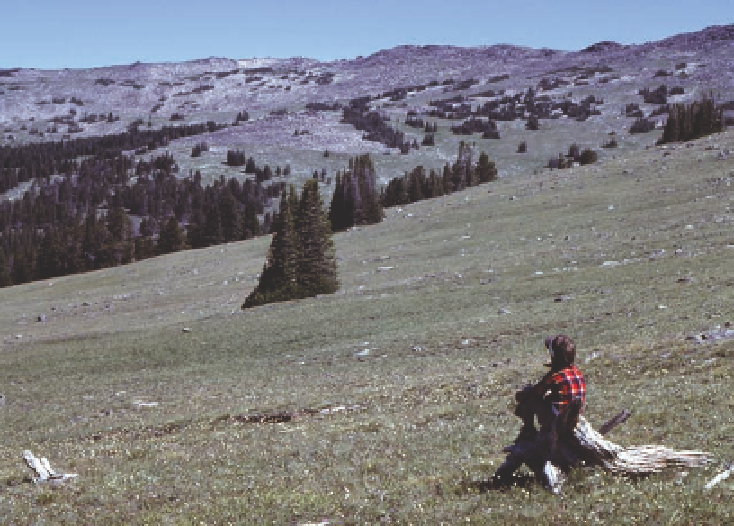Geoscience Reference
In-Depth Information
Fig. 14.2. Upper treeline in the Bighorn
Mountains. the trees are engelmann
spruce and subalpine fir. common
plants in the alpine turf are alpine
avens, alpine bistort, alpine forget-me-
not, alpine sagewort, blackroot sedge,
selaginella, stonecrop, and spike tri-
setum. elevation 9,600 feet.
sure also is important in determining the limits of tree
growth, with treelines often at higher elevations on
the warmer south slopes with less snow cover. north
and west slopes tend to have more snow later into the
itous circumstances. William K. Smith and his associ-
ates, working in the Medicine Bow Mountains, found
that seedling establishment was facilitated when the
area around the seedling favored a moderate amount of
snow cover, providing protection from abrasion and des-
iccation during winter. As important, they found that
seedlings required at least a minimum of plant cover to
provide shade during the summer, not just from intense
alpine sunlight during the day but also from the cold
unshaded leaves could be colder than the minimum air
temperatures on near-freezing summer nights, which
was found to inhibit photosynthesis the following day.
Summertime freezing is detrimental to plants and is
much more likely to occur when they are exposed to
the night sky. Moreover, unshaded leaves were consid-
erably warmer than the maximum air temperature on
a summer day, which greatly increased rates of water
loss and the likelihood of wilting. With adequate but
not excessive shading, seedlings have photosynthetic
rates that are sufficient for plant growth and the for-
mation of mycorrhizae—which in turn lessens water
stress. the seedling's future is secured when the young
tree is large enough to cause snow accumulation over
its own branches for a sufficiently long time during the
winter, or if the neighboring plants or microtopography
cause the needed snow drifting. this research suggests
Krummholz
the trees commonly found at treeline are engelmann
spruce, subalpine fir, limber pine, and, in the Greater
elevation. on exposed sites the trees have a windswept,
shrubby growth form known as
krummholz,
a German
word meaning twisted wood. Some have vertical trunks
flagged with branches on the leeward side, caused by the
abrasion of blowing ice and snow that prevent branch
growth upwind (fig. 14.3). Branches and the needle-
shaped leaves near the ground are denser, forming a mat
that accumulates a protective snowdrift in winter. the
shrubby trees are widely spaced in a matrix of alpine
tundra and subalpine meadows. in some wind-exposed
places they occur in ribbons because of the interactive
effect of wind, snow deposition, and slight changes in
topography (see chapter 13).
the stunted trees can be very old. Most likely they
became established when a seedling managed to survive
for several years because of a rare combination of fortu-

Search WWH ::

Custom Search